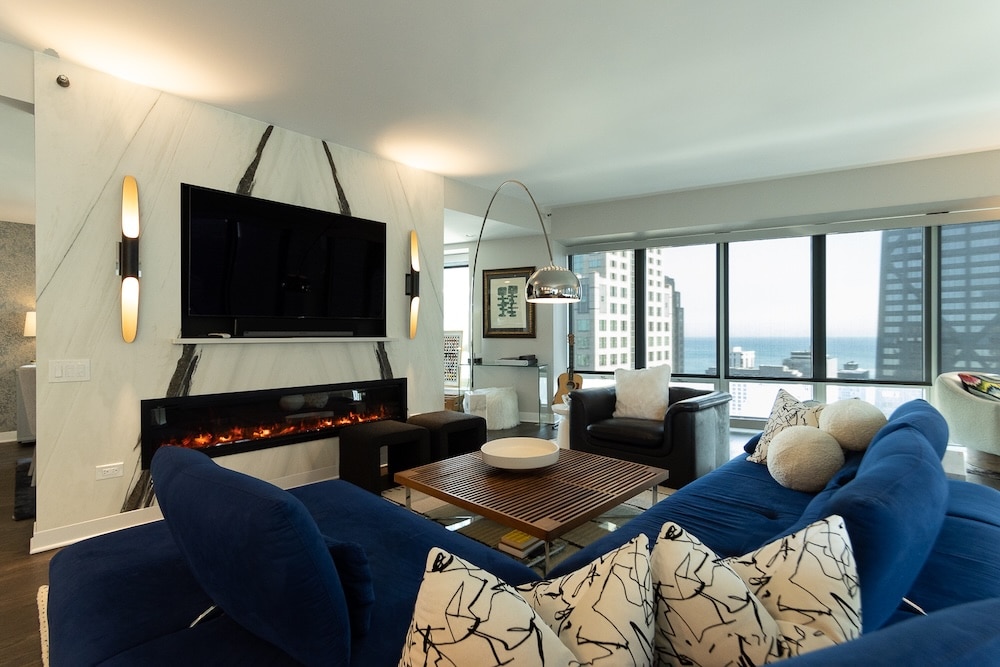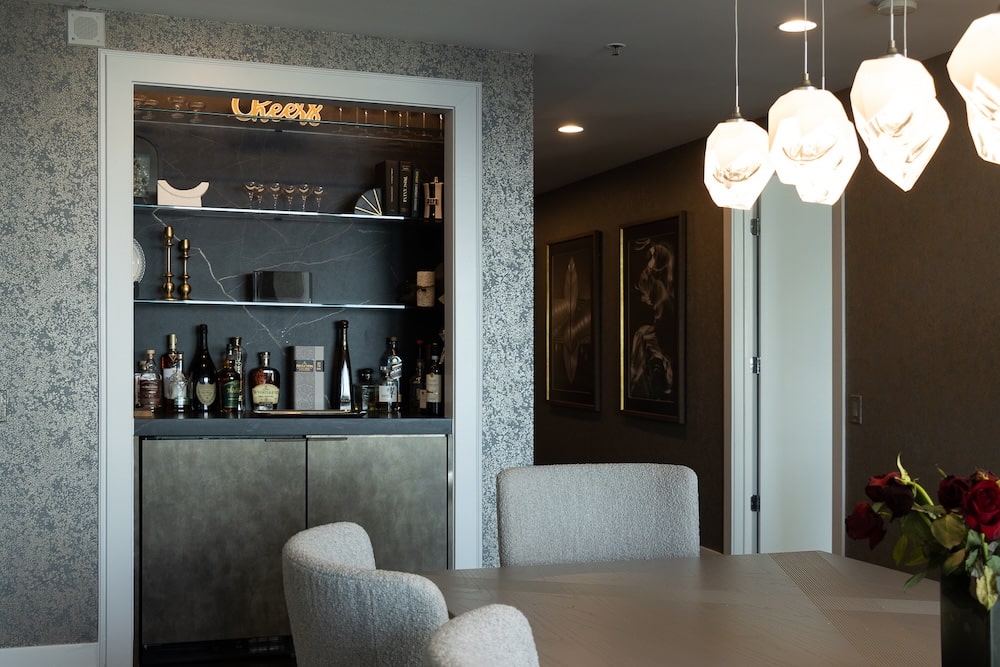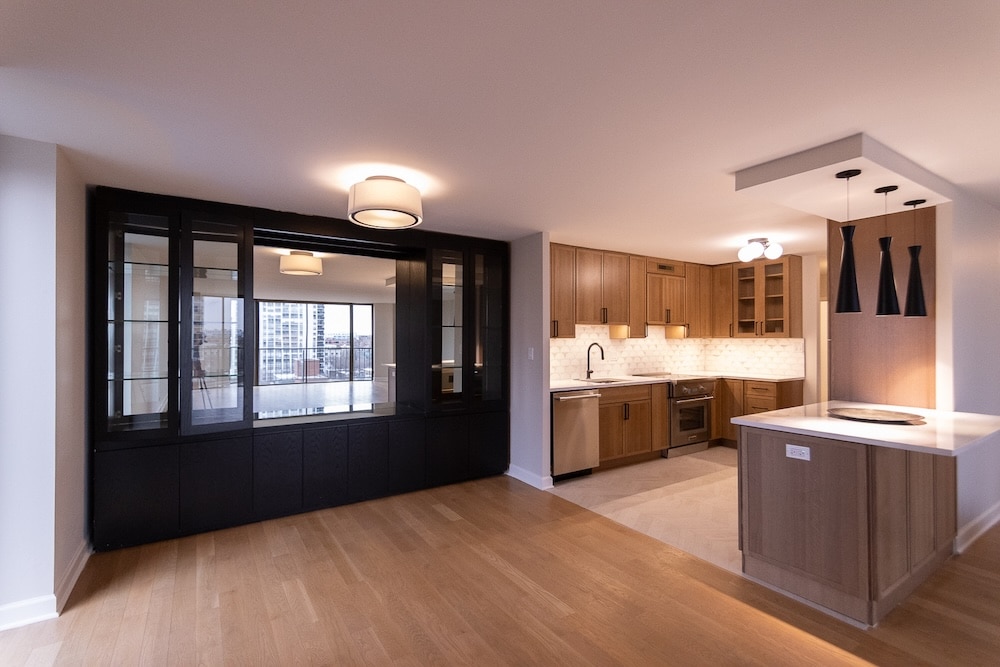Should You Consider an Open Concept Living Room for Your Chicago Home?

An open concept layout removes traditional walls between the kitchen, dining room, and living room, offering Chicago homeowners a completely different way to experience their living space.
The appeal of open concept design goes beyond current trends. Families value the connection these layouts create. Parents can prepare dinner while watching their children play in the living area. The design maximizes square footage. It also makes smaller homes feel more spacious and accommodating.
However, open concept living isn’t right for every household. But no need to worry! Our design team is highly skilled in implementing this layout and will work with you to determine if it aligns with your lifestyle and needs.
What Makes Open Concept Living So Popular?
Open concept design eliminates interior walls to create one large, multifunctional space. This architectural approach gained popularity in the 1990s and has remained a dominant trend in home design ever since. Real estate listings frequently highlight open concept layouts as a key selling point, and many homeowners specifically seek out these flexible spaces.
The concept stems from mid-century modern architecture, which emphasized clean lines and flowing spaces.
Today’s open concept designs build on this foundation, creating homes that feel more connected to both their inhabitants and the surrounding environment.
The Advantages of Open Concept Living Rooms
Increased Natural Light
Removing walls allows natural light to flow freely throughout the space, brightening areas that might otherwise feel dark or cramped. Windows in the kitchen can illuminate the dining area, while living room windows cast light into previously separated spaces. This enhanced brightness creates a more welcoming atmosphere and can even help reduce electricity costs during daylight hours, making it an eco-friendly choice.
The improved light distribution also makes colors appear more vibrant and spaces feel larger. Natural light not only reduces reliance on artificial lighting but also has proven psychological benefits, including improved mood and increased productivity, making open concept homes feel more comfortable, energizing, and environmentally friendly.
Enhanced Social Interaction
Open concept layouts naturally encourage conversation and connection. The cook can chat with guests seated at the dining table, while children playing in the living area remain part of the family conversation. This connectivity strengthens relationships and makes everyday activities more social and enjoyable.
During gatherings, hosts no longer feel isolated in the kitchen while guests congregate elsewhere. Everyone becomes part of the same shared experience, creating a more inclusive and engaging environment for entertaining.
Flexible Space for Entertaining
Large, open areas accommodate various entertaining styles, from intimate dinner parties to larger celebrations. Furniture can be rearranged easily to create different seating arrangements or to open up space for activities. The flexible nature of open concept design allows homeowners to adapt their space to different occasions and group sizes.
This versatility also supports changing lifestyle needs. Families with young children can create play areas that later transform into homework spaces or adult conversation zones as children grow.
The Challenges of Open Concept Living
Noise Control Issues
Without walls to absorb sound, noise travels freely throughout open concept spaces. Television volume, kitchen activities, and conversations can create competing audio environments. Families may struggle to enjoy different activities simultaneously—reading quietly while someone watches TV or prepares a meal becomes challenging.
Hard surfaces common in open concept designs, such as hardwood floors and granite countertops, can amplify sound rather than absorb it. This acoustic challenge requires thoughtful design solutions to create comfortable living environments.
Lack of Privacy
Open layouts offer little opportunity for solitude or quiet activities. Working from home becomes difficult when family members are cooking, watching television, or socializing nearby. Personal phone calls, focused work, and peaceful relaxation all become more challenging in completely open environments.
Some family members may feel constantly “on display,” unable to relax fully when everyone shares the same visual space. This can create stress and reduce the home’s ability to serve as a peaceful retreat.
Heating and Cooling Challenges
Large, open spaces require more energy to heat and cool effectively. Temperature regulation becomes more complex when trying to keep one large area comfortable rather than smaller, individual rooms. High ceilings common in open concept designs can exacerbate this issue, as heated air rises and cooled air settles unevenly.
HVAC systems may need to work harder to maintain consistent temperatures, potentially increasing utility costs. Strategic ceiling fan placement and zoning systems can help address these challenges, but require additional planning and investment.
Design Tips for Open Concept Living Rooms
Define Zones with Furniture and Rugs
Create distinct areas within your open space using furniture placement and area rugs. Position a sofa with its back toward the dining area to create natural separation, or use a console table behind seating to define the living room boundary. Large area rugs help establish specific zones while maintaining visual flow between areas.
Bookcases, room dividers, or even large plants can provide subtle separation without blocking light or sightlines. These elements offer the benefits of defined spaces while preserving the open feel that makes this layout appealing.
Use Consistent Color Schemes
Maintain visual cohesion throughout your open concept space with a unified color palette. Choose two to three main colors and repeat them in different areas through accessories, artwork, and textiles. This approach creates harmony while allowing each zone to have its own personality.
Consider using different shades of the same color family to add depth while maintaining consistency. For example, use light gray in the living area, medium gray in the dining space, and charcoal accents in the kitchen zone.
Incorporate Smart Storage Solutions
Open concept living requires strategic storage to prevent clutter from overwhelming the space. Built-in storage, such as window seats with hidden compartments or dining room hutches, can house items while contributing to the room’s design. Multi-functional furniture, like ottomans with storage or console tables with shelving, maximizes utility without adding visual bulk.
Consider closed storage options for items you use daily but don’t want displayed. This helps maintain the clean, uncluttered look that makes open concept spaces feel spacious and organized.
Making Open Concept Work for Your Lifestyle
Successfully implementing open concept design requires an honest assessment of your family’s needs and lifestyle. Consider how you use your current spaces and whether removing barriers would enhance or complicate daily routines. Some families thrive in the connected environment, while others miss the quiet retreats that separate rooms provide.
Partial open concept designs offer middle-ground solutions. Maintaining one private room, such as a home office or formal dining room, can provide necessary quiet space while still enjoying the benefits of open living areas.
Creating Your Ideal Living Space
Open concept living rooms offer compelling benefits for families who value connection, light, and flexibility. However, the challenges of noise, privacy, and temperature control require thoughtful consideration and strategic design solutions.
The right furniture placement, color choices, and storage solutions can maximize the advantages while minimizing potential drawbacks.
Ready to transform your living space?
Areté’s experienced design professionals can help you determine whether open concept living suits your lifestyle and create a beautiful, functional space that works for your family. Call us at 773.683.3033 or contact us today to explore your home’s potential and discover design solutions that enhance both beauty and livability.

